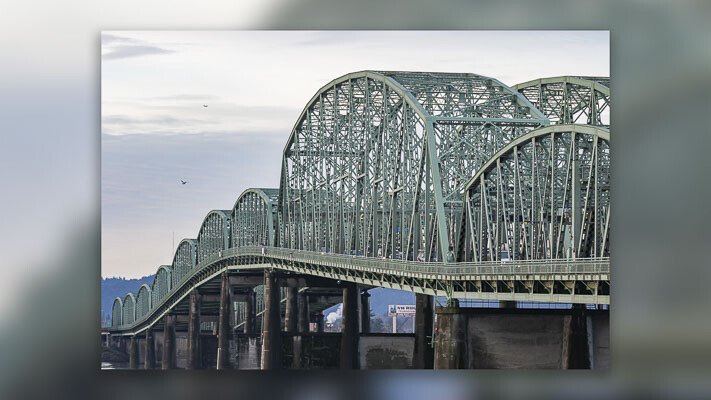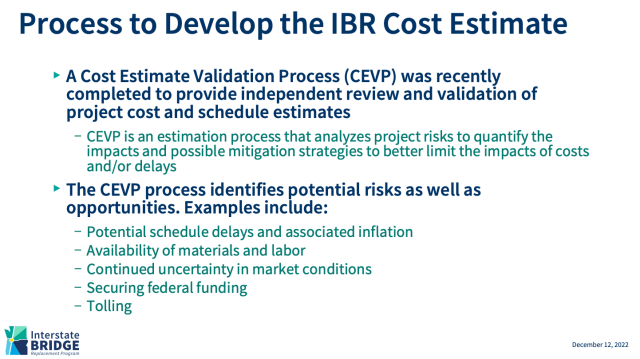
Joe Cortright addresses the estimated cost of the Interstate Bridge replacement project, which has ballooned as high as $7.5 billion
Joe Cortright
City Observatory
Oregon Department of Transportation (ODOT) has a history of enormous cost overruns, and officials just told the Oregon and Washington state legislatures that the cost of the I-5 Bridge Replacement Program (IBR) had ballooned 54 percent, to as much as $7.5 billion.
To allay fears of poor management and further cost overruns, IBR officials testified they had completed a “Cost Estimate Validation Process” (CEVP). They assured legislators they had consulted independent subject matter experts and assessed more than 100 risks.
But asked for copies of the CEVP under the public records law, agency officials reported “no records exist” of the CEVP.
And the supposedly “nationally recognized” CEVP process has been around for more than a decade, was judged inadequate and error-filled for the Columbia River Crossing, and failed to detect key cost and schedule risks.
ODOT and WSDOT are more interested in deflecting criticism than in being accountable for — and correcting — runaway project costs.
- IBR, December 2022 Legislative Testimony: “A CEVP was recently completed.”
- IBR, January 2023 response to public records request for the CEVP: “No records exist.”
The Oregon and Washington highway departments are pushing forward with something they call the “Interstate Bridge Replacement Project.” As we’ve pointed out at City Observatory, this project, which is actually a clone of the Columbia River Crossing that died a decade ago, is really a 5-mile long freeway widening project. And it’s one whose cost has ballooned to as much as $7.5 billion, according to estimates revealed in December 2022. This is part of a consistent pattern, the Oregon Department of Transportation has a long string of 100 percent cost-overruns on its major projects. Almost every large project the agency has undertaken in the past 20 years has ended up costing at least double — and sometimes triple — its original cost estimate.
While the agency wants to blame recent construction cost inflation for the increase, that’s simply wrong. The transportation agencies official projections of future construction price inflation show a negligible change from 2020 levels. Higher construction cost inflation accounts for only $300 million of a $2.7 billion cost increase over their 2020 estimate.
Don’t Worry About Cost Overruns, We did a CEVP™!
At the Dec. 12, 2022 meeting of the Joint Oregon-Washington I-5 Bridge Legislative Oversight Committee, IBR administrators tried to buffer concerns about rising project costs by invoking a Cost Estimate Validation Process or “CEVP “process as a way to diagnose and prevent further cost escalation.

IBR Administrator Frank Green testified:
“It’s a process that enables us to identify costs . . .we also go through a process where we bring subject matter experts to identify, on a program like this, what are some of the potential risks that we may encounter as we’re moving through development of the program.
. . . as we produce our CEVP report and publish it, it will show the list of risks, well over a hundred, that our team and our partners and our subject matter experts identified. It’s important to understand that we also identified strategies that we as a team and our partners can take to minimize the potential impact of these risks’’
Joint I-5 Committee Meeting, December 12, 2022
This explanation of the Cost Estimate Validation Process was also posted to the IBR project website (emphasis added):
A Cost Estimate Validation Process (CEVP) was recently completed to provide independent review and validation of project cost and schedule estimates.
A CEVP is an estimation process that analyzes risks specific to the project to quantify the impacts and possible mitigation strategies in seeking to limit the impacts of costs and or delays. Cost risks identified for the IBR program are primarily tied to possible schedule delays, although market uncertainties, changes during construction, and design modifications can all pose a risk to cost escalation. Some specific risks identified in the CVEP include:
- Possible legal challenges of program environmental process
- In-water work complexities during bridge construction
- Delay in state matching funds
“No Records Exist” of a current CEVP
Intrigued to learn more, City Observatory filed a public records request with WSDOT (one of IBR’s two parent state agencies) asking for copies of the CEVP. We were told that there were no written or electronic records pertaining to the CEVP, and that none would be available before March of 2023 — more than ninety days after the IBR testified to the Legislature that the CEVP was “completed.” Their official response to our request — ”No Records Exist”–is shown here:

At this point, there’s simply no evidence that WSDOT undertook any kind of analysis. They just gravely intoned the words “CEVP” and assured that this would insulate the project from future costs and risks. If there’s no documentation, no electronic files there’s simply nothing to substantiate that any kind of analysis was actually performed. It’s hard to see how such an insubstantial or poorly documented process will do anything to prevent or manage future cost overruns.
One has to believe that IBR, according to its own testimony, generated (and analyzed) a list of more than 100 risks, and reviewed them with subject matter experts, without creating a single document, electronic file or other public record.
Apparently, just as former President Donald Trump can declassify a document just by thinking about it, WSDOT and ODOT can perform a CEVP without creating a single document or electronic file. This strongly suggests that the real purpose of a CEVP is to distract legislators, not identify or prevent budget or schedule risks.
Deja Vu all over again: The CEVP has proven a failure at predicting or preventing cost-overruns for this very project
Whether a CEVP actually exists as a tangible object or not is an open question. An equally important question is whether a CEVP, if one existed, would do anything to accurately predict, or prevent further cost escalation and schedule delays. Unfortunately, the history of CEVP with exactly this project shows it did nothing to forestall mistakes, delays and cost increases.
It’s too bad that none of today’s Oregon legislators were on hand the last time they were discussing a huge and risky bridge over the Columbia River, because “CEVP!” is exactly what ODOT officials claimed would avoid cost overruns, when they were asking for funding for the then $3 billon failed Columbia River Crossing (CRC) project (which has been revived as the IBR). Twelve years ago, in 2011, ODOT consultant and gubernatorial advisor Patricia McCaig confidently told Oregon Legislators that they had a handle on project costs, because of Washington’s CEVP process.
“There is a cost estimating validation process called CEVP from Washington, that is a nationally known model that is applied to the Columbia River Crossing and we will spend as much time as you as like to go through that with you.” – Hearing on HJM 22, House Transportation and Economic Development Committee, March 30, 2011
Also read:
- Opinion: Hiding the growing cost of the Interstate Bridge replacementJoe Cortright of the City Observatory addresses the rising cost of the Interstate 5 Bridge replacement project.
- 90 minutes of delay on Southbound I-5 in Southwest Washington on Friday afternoon, July 26Travelers using southbound Interstate 5 through Woodland should expect up to 90 minutes of delay during Friday afternoon and evening and should delay travel or prepare for additional travel time.
- Nighttime paving work on I-5 and SR 14 in Clark County July 28-Aug. 9Nighttime travelers in Clark County should expect delays for maintenance and paving work beginning Sunday, July 28 until the morning of Friday, Aug. 9.
- Northeast 182nd Avenue/Northeast Ward Road to be closed on Aug. 1Northeast 182nd Avenue and Northeast 172nd Avenue in Clark County will have single-day closures on August 1 and August 5 for road preservation, with detours in place.
- Interstate Bridge Replacement program awarded $1.499 billion FHWA Bridge Investment Program grantInterstate Bridge Replacement program officials have shared that the program received $1.499 billion through the Federal Highway Administration’s Bridge Investment Program.









